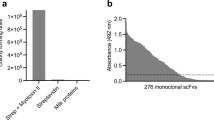Abstract.
In recent years, several molecular engineering methods of designing bispecific antibodies in various formats have been developed. Tandem-scFvs comprising two scFvs fused together via a peptide are 55-kDa molecules, and are one of the most promising and most straightforward approaches to bispecific antibody production. We report an attempt to design more effective antivenoms to the Androctonus australis scorpion using murine scFvs as building blocks to create a unique bispecific molecule that neutralizes the potent neurotoxins AahI and AahII. The tandem-scFv was produced in recombinant bacteria, purified by immobilized metal ion affinity chromatography, and analyzed by polyacrylamide gel electrophoresis, Western blot, gel filtration, mass spectrometry, and direct and competitive radioimmunoassay. In vivo, it neutralized the binding of the AahI and AahII toxins to their receptor, and protected mice against experimental envenomation. The findings reported here highlight the potential of recombinant antibody fragments for protecting against scorpion venom toxicity.
Similar content being viewed by others
Author information
Authors and Affiliations
Corresponding author
Additional information
Received 8 September 2006; received after revision 10 November 2006; accepted 27 November 2006
Rights and permissions
About this article
Cite this article
Juste, M., Martin-Eauclaire, M.F., Devaux, C. et al. Using a recombinant bispecific antibody to block Na+-channel toxins protects against experimental scorpion envenoming. Cell. Mol. Life Sci. 64, 206–218 (2007). https://doi.org/10.1007/s00018-006-6401-3
Published:
Issue Date:
DOI: https://doi.org/10.1007/s00018-006-6401-3




